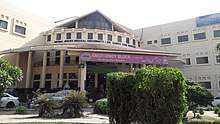Sir Ganga Ram Hospital (Pakistan)
Sir Ganga Ram Hospital (Urdu: سر گنگا رام ہسپتال) is a 550-bed hospital in Lahore, Pakistan.[1] This was the original hospital established by Sir Ganga Ram, a Civil Engineer who served the British Government.[2] He established it in 1921 at Lahore, British India, 26 years before the Partition of British India.
| Sir Ganga Ram Hospital, Lahore | |
|---|---|
 Sir Ganga Ram Hospital, Lahore | |
| Geography | |
| Location | Lahore, Punjab, Pakistan, Pakistan |
| Organisation | |
| Type | Teaching |
| Affiliated university | Fatima Jinnah Medical College |
| Services | |
| Emergency department | Yes |
| Beds | 831 |
| History | |
| Opened | 1921 |
| Links | |
| Lists | Hospitals in Pakistan |
History
Sir Ganga Ram Hospital was established in 1921, at the end of WWI in the walled city of Lahore, India. The benefactor, Sir Ganga Ram, was a civil engineer and leading philanthropist of his time who also donated land for the site. In 1943 during WWII, the hospital was shifted to its present location to cope with the growing demand for medical and health care services. After Partition, India, built another "Sir Ganga Ram Hospital" in New Delhi.
Associated medical college
In 1944 the family of Sir Ganga Ram started a medical college by the name Balak Ram Medical College named after a son of Sir Ganga Ram. The college was closed soon after independence in 1947 and its premises abandoned. Fatima Jinnah Medical College, Lahore was established in 1948 in the same premises and named after Mohtarma Fatima Jinnah, the sister of Mohammad Ali Jinnah.
Sir Ganga Ram Hospital is now an affiliated hospital to the Fatima Jinnah Medical College. It is now being extended over another 22 kanals land and will provide an additional 400 beds. The name of this new hospital (extension) is Fatima Jinnah Hospital. Although it is an all female medical college, the faculty consists of highly qualified male as well as female teachers. The college has well-equipped laboratories, airconditioned dissection hall, lecture theatres with audio-visual aids for teaching purposes, pathology museum, clinical academic rooms, a well-equipped library and an auditorium for seminars and international conferences. A purpose-built accident and emergency department has been added.
The hostel for students is within walking distance from the college. It consists of six blocks. Two new blocks are being built to accommodate more students. At the moment there are around one thousand students living in the hostel.
In literature
A marble statue of Sir Ganga Ram once stood in a public square on Mall Road in Lahore. Famous Urdu writer Saadat Hasan Manto (known for his famous satire "Toba Tek Singh") wrote a satire on persons who were trying to obliterate any memory of any Hindu in Lahore after Pakistan came into existence. In his story "Garland" based on a true incident on the frenzy of religious riots of 1947, an inflamed mob in Lahore, after attacking a residential area, turned to attacking the statue of Sir Ganga Ram, the great Hindu philanthropist of Lahore. They first pelted the statue with stones; then smothered its face with coal tar. Then a man made a garland of old shoes climbed up to put it round the neck of the statue. The police arrived and opened fire. Among the injured were the fellow with the garland of old shoes. As he fell, the mob shouted: “Let us rush him to Sir Ganga Ram Hospital” forgetting that they were trying to obliterate the memory of the very person who had founded the hospital where the person was to be taken for saving his life.[3][4]
References
- SIR GANGA RAM HOSPITAL Archived 4 March 2009 at the Wayback Machine
- Maneesha Tikekar (2004). Across the Wagah: An Indian's Sojourn in Pakistan. Bibliophile South Asia. pp. 85–. ISBN 978-81-85002-34-7.
- http://www.thenews.com.pk/Todays-News-9-107485-Manto-from-heaven
- The Public Sculptures of Historic Lahore, Raza Rumi, Posted on April 17, 2007